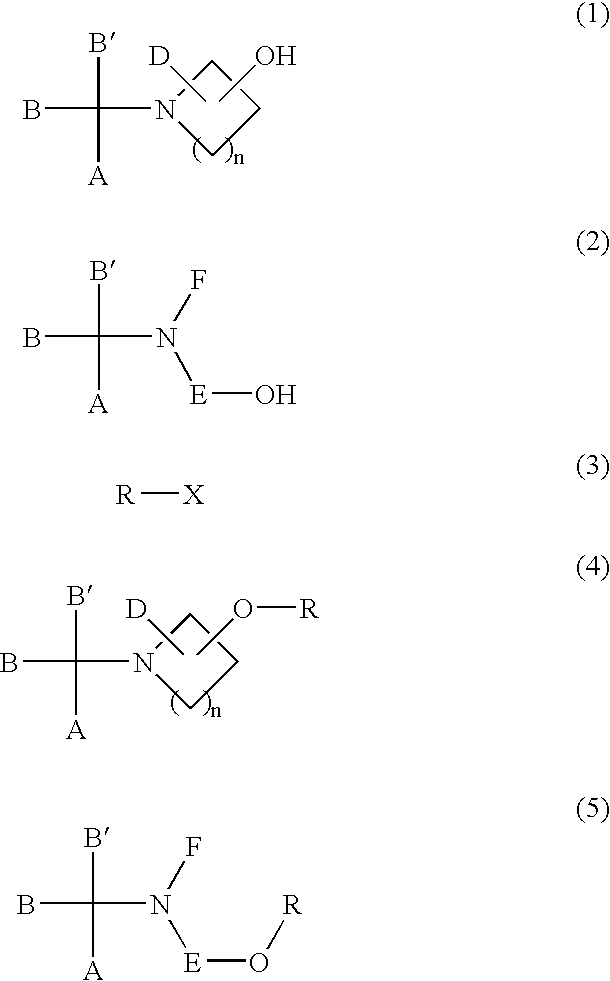Process for the production of sulfonic esters
a technology of sulfonic acid ester and ester derivative, which is applied in the preparation of sulfonic acid esters, organic chemistry, chemistry apparatus and processes, etc., can solve the problems of high cost of organic base, high cost of water-prohibiting base itself, and economic difficulties in purification process
- Summary
- Abstract
- Description
- Claims
- Application Information
AI Technical Summary
Benefits of technology
Problems solved by technology
Method used
Image
Examples
example 1
[0053] (S)-1-Benzyl-3-pyrrolidinol (44.35 g), 132.77 g of toluene and 166.71 g of a 30% aqueous solution of NaOH were respectively weighed and placed in a 500-mL four-necked flask. While the mixture was stirred, the flask inside temperature was lowered to 6.5.degree. C. Then, 63.14 g of methanesulfonyl chloride was added dropwise over 4 hours and 14 minutes at a flask inside temperature of 5 to 10.degree. C. Water (35 mL) was added to dissolve the NaCl which had precipitated out in the aqueous phase, and the mixture was separated into the toluene phase and aqueous phase.
[0054] The toluene phase was concentrated using an evaporator, whereby concentrated (S)-1-benzyl-3-pyrrolidinol methanesulfonate was obtained as a pale-yellow oil in a yield of 94.8 mole percent. In the step of concentration, the toluene was recovered with a recovery rate of 95%.
example 2
[0055] Except that the toluene recovered in Example 1 was used as the reaction solvent without any purification procedure, the procedure of Example 1 was otherwise repeated to give concentrated (S)-1-benzyl-3-pyrrolidinol methanesulfonate as a pale-yellow oil in a yield of 94.0 mole percent.
example 3
[0056] N-Benzyl-N-methyl-ethanolamine (20.73 g), 61.94 g of toluene and 83.41 g of a 30% aqueous solution of NaOH were respectively weighed and placed in a 300-mL four-necked flask. While the mixture was stirred, the flask inside temperature was lowered to 6.8.degree. C. Then, 31.68 g of methanesulfonyl chloride was added dropwise over 3 hours and 17 minutes at a flask inside temperature of 5 to 10.degree. C. Water (33 mL) was added to dissolve the NaCl which had precipitated out in the aqueous phase, and the mixture was separated into the toluene phase and aqueous phase. A toluene solution of N-benzyl-N-methyl-ethanolamine methanesulfonate was thus obtained in a yield of 68.8 mole percent.
PUM
| Property | Measurement | Unit |
|---|---|---|
| boiling point | aaaaa | aaaaa |
| boiling point | aaaaa | aaaaa |
| boiling point | aaaaa | aaaaa |
Abstract
Description
Claims
Application Information
 Login to View More
Login to View More - R&D
- Intellectual Property
- Life Sciences
- Materials
- Tech Scout
- Unparalleled Data Quality
- Higher Quality Content
- 60% Fewer Hallucinations
Browse by: Latest US Patents, China's latest patents, Technical Efficacy Thesaurus, Application Domain, Technology Topic, Popular Technical Reports.
© 2025 PatSnap. All rights reserved.Legal|Privacy policy|Modern Slavery Act Transparency Statement|Sitemap|About US| Contact US: help@patsnap.com



